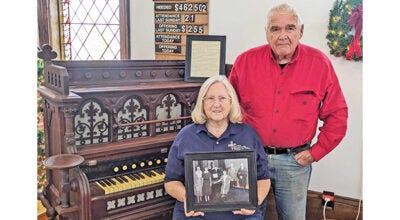A Conversation with an Artist: John Lidecker
Published 10:55 am Monday, January 27, 2014
NILES — Recently, I had the opportunity to sit and talk with artist John Lidecker over a cup of coffee at the Olfactory Hue Bistro in Niles. Here are some excerpts from that conversation.
OTW: John, you call yourself “the world’s most ‘unfamous’ artist.” How do you judge that?
JL: I’ve been kind of like a recluse about marketing my art, and through my lifetime and through my career, I have art pieces placed throughout the world and throughout the states, and I’ve never really pushed it. My own personal art that I keep, they’re like children to me, and I’ve always been very reluctant about letting them go until recently.
OTW: What has changed that you are now more willing to let them go off on their own?
JL: I need retirement. (Laughing.) Part of it was that I was doing an event. I think it was that. The first time that I did it—the technique that I use—I was performing it in front of an audience here in town, and I got into it so much, and so did the audience. And then I found myself going deeper into it and thinking, “I want to let it go now. I want to give it, or sell it, or whatever.”
OTW: You mentioned that you were doing things that were rather Jackson Pollack-esque, and you’ve sort of moved beyond that. Now, you are doing something new. Can you describe that?
JL: This all began in 2012. I was doing a painting, and I didn’t like the painting, so I re-did it three times. And I was working on it, and I finished it up one evening, and I just kind of stepped back, and I looked at it, and I still had a brush in my hand, and I just said “That’s it.” And, when I did that, I flipped my brush, and the brush had paint on it, so it just sort of splattered all over the painting, and I looked at it for a moment, and I just started throwing paint on it.
And, I just set it off to the side.
Then, a friend of mine came over one day, and she saw the painting sitting in a corner. She said, “Oh my god, how much?” I said, “I can’t sell it,” but she said, “How much?” I said, “Take it.” And she said, “I can’t do that,” so I said, “Make me some cookies.”
So, she made me some cookies, and she got the painting, and she said “You really need to do something with this,” and that’s how it started.
OTW: What inspires you? Where do your paintings come from? Or is that a silly question?
JL: No, it’s a tough question. It gives me a reason for being. The feelings become so strong and intense that I can find myself being every elated or very depressed, and I have to get that out in front of me.
So, when I see it before me, it’s the end product of what I was feeling at that time. …But, it’s like a part of me that is there. That’s why there’s the reluctance to let it go—because there’s a lot of emotion packed into that canvas.
OTW: Who are some of the artists that you are inspired by?
JL: I think my hero is Picasso, and I think I have a similar journey. He started out doing life paintings and there was a lot of control, conformity and so forth, and then he started experimenting with other artists, and then, of course, it got to the point where he was just taking everything, and it’s just become an obliteration and an abomination of what was acceptable. He and Pollack.
Understanding Pollack, and there’s that kinship one can find, and especially I with Pollack, because his mind—he was so tormented by what was going on in his mind, and for what he did, it was just an escape, and that was his outlet.
OTW: Do you typically paint in acrylics or oils or something else?
JL: Acrylics. Most of the paintings are done in acrylics and latexes and so forth. The only oils I use are Rust-Oleum. What I’ll do is, I’ll soak the canvas in a latex paint, and then I’ll shape it, I’ll give it some form, maybe ripples, wrinkles, whatever, and I’ll let it dry, and then I’ll paint with the Rust-Oleum because the Rust-Oleum will harden and keep those wrinkles permanent.
OTW: Do they have titles?
JL: Most of my paintings do not have a title because paintings are seen by other people, and if you title it, you’ve lost what they can see in it. Not everybody interprets an image as everybody else does—not in the same way.
OTW: If people would like to see your work, how could they see it?
JL: People could come and visit me personally. They can call me at (574) 276-1497.






